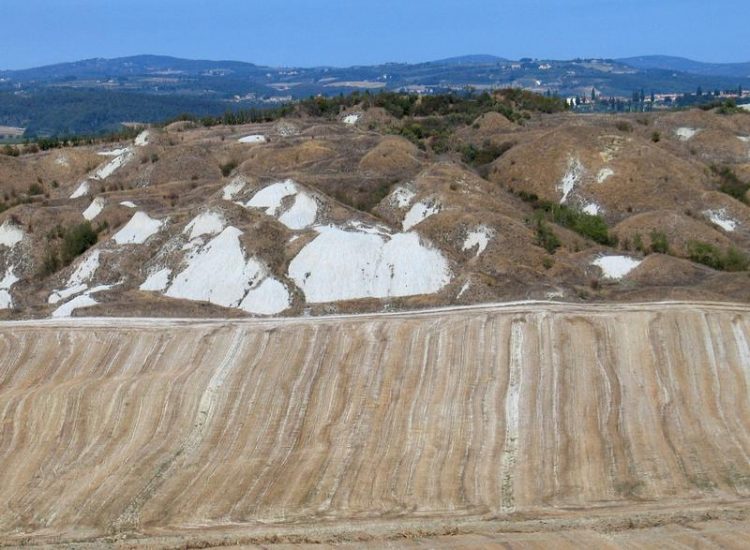Where nothing grows anymore

The region known as ‘Crete Senesi’ between Florence and Grosseto. The small hills are typically characterized by erosion. Photo: Beate Michalzik/FSU
Vast fields of sunflowers, sprawling pine trees and slim cypresses, as well as vineyards as far as the eye can see – these are typical memories of Tuscany for all those who have been there.
By contrast, Professor Dr. Beate Michalzik from the Friedrich Schiller University of Jena and her colleagues are interested in the more barren aspects of the region in Central Italy: In a study the Jena geographers analyzed the condition of the soil in the region known as ‘Crete Senesi’ between Florence and Grosseto, whose hills are typically characterized by erosion – for the moment at least, because the so-called badlands of Tuscany are acutely endangered.
“Erosion is threatening the many small peaks known as biancane’ due to their whitish color. They are marked by a bleak, strongly declining south side and a less declining north side, overgrown by herbs”, Prof. Michalzik explains. Every year one to two centimeters of the loose bare ground on the south side of the slope are being eaten away by wind and weather.
But why, asked the chair of Soil Science, is there a protective blanket of sage brush, orchard grass, wild rye and curry plant only on one side of the hill and not on the other one? Michalzik and two former students from Jena tried to literally unearth the answer to this question. As Peggy Bierbaß, Michael Wündsch and Beate Michalzik write in the science magazine ‘Catena‘: this typically Tuscan landscape is the result of an intense interplay of the condition of the soil, the vegetation and the land-use (DOI: 10.1016/j.catena.2013.08.003).
In the Val d’Orcia, about 30 kilometers south of Siena, the Jena students and their supervisors took 12 samples of the soil of a biancana hill within the context of fieldwork. In the laboratory they analyzed their chemical, physical and hydrological qualities and discovered that the concentration of sodium in the soil is crucial for its stability.
“In the barren part of the hills the concentration of sodium is distinctly higher than on the vegetated side,” Michael Wündsch explains the central finding. The high concentration of sodium lowers the coagulation of the individual layers of clay and therefore they are more easily affected by the rain. The result: less stability and more erosion.
An additional reason can be found in the vegetation itself. “In places where something once grew, organic material finds its way into the ground and serves as a kind of intercellular cement and protects the ground from erosion,” Peggy Bierbaß says. Moreover, the vegetation leads to a better overall wetting mesh, which adds to the greening and also protects the ground.
A targeted greening of the barren surfaces of the biancane hills could possibly stabilize them. However, Beate Michalzik explains, this wouldn’t stop the gradual disappearance of this landscape either, as can be seen by the growing agricultural use of the region.
“In the last decades bigger and bigger stretches of land have been used for wheat growing, which takes away the unique character of this landscape,” states Michalzik. According to today’s estimates, the badlands of Tuscany will have disappeared completely in 35 to 40 years.
Original Publication:
Bierbaß P et al. The impact of vegetation on the stability of dispersive material forming biancane badlands in Val d’Orcia, Tuscany, Central Italy, Catena 113 (2014) 260–266, DOI: 10.1016/j.catena.2013.08.003
Contact:
Prof. Dr. Beate Michalzik, Michael Wündsch
Institute of Geography
Friedrich Schiller University of Jena
Löbdergraben 32, 07743 Jena
Germany
Phone: ++49 3641 948820, ++49 3641 948807
Email: beate.michalzik[at]uni-jena.de, michael.wuendsch[at]uni-jena.de
Media Contact
All latest news from the category: Earth Sciences
Earth Sciences (also referred to as Geosciences), which deals with basic issues surrounding our planet, plays a vital role in the area of energy and raw materials supply.
Earth Sciences comprises subjects such as geology, geography, geological informatics, paleontology, mineralogy, petrography, crystallography, geophysics, geodesy, glaciology, cartography, photogrammetry, meteorology and seismology, early-warning systems, earthquake research and polar research.
Newest articles

Properties of new materials for microchips
… can now be measured well. Reseachers of Delft University of Technology demonstrated measuring performance properties of ultrathin silicon membranes. Making ever smaller and more powerful chips requires new ultrathin…

Floating solar’s potential
… to support sustainable development by addressing climate, water, and energy goals holistically. A new study published this week in Nature Energy raises the potential for floating solar photovoltaics (FPV)…

Skyrmions move at record speeds
… a step towards the computing of the future. An international research team led by scientists from the CNRS1 has discovered that the magnetic nanobubbles2 known as skyrmions can be…




















